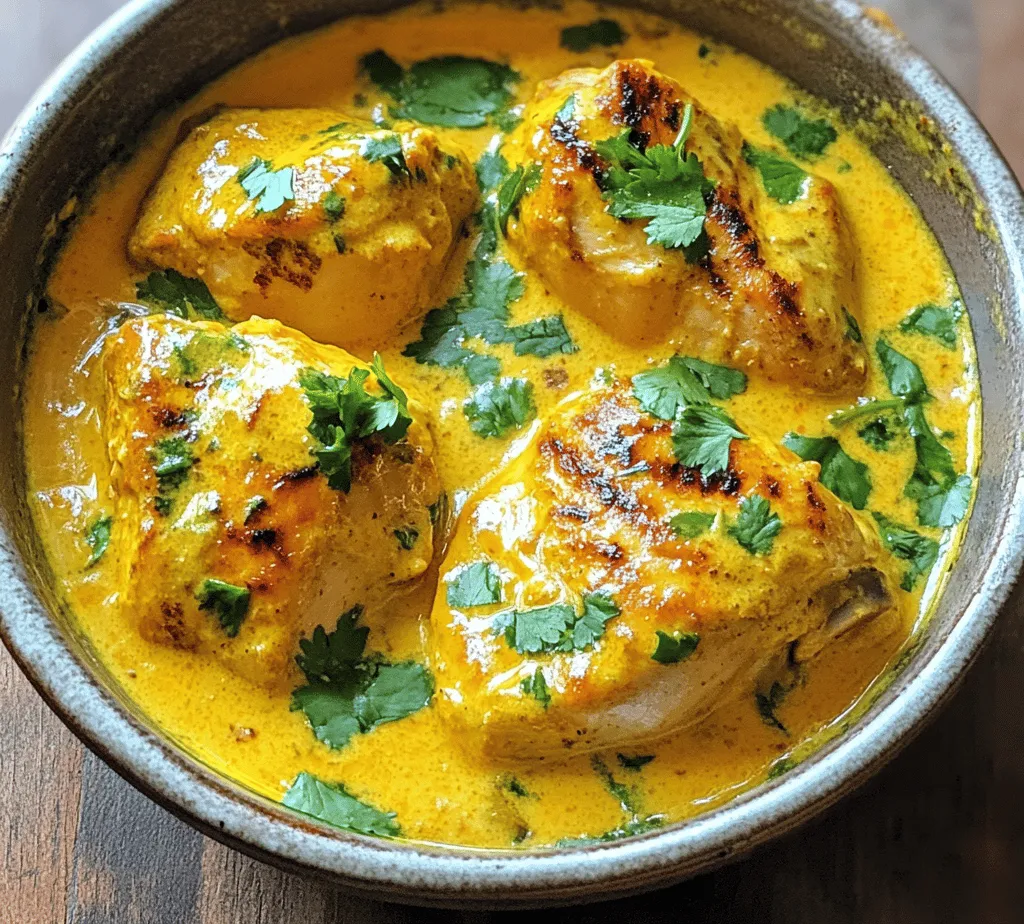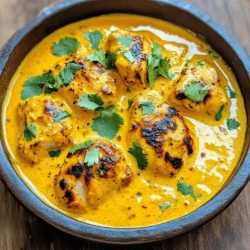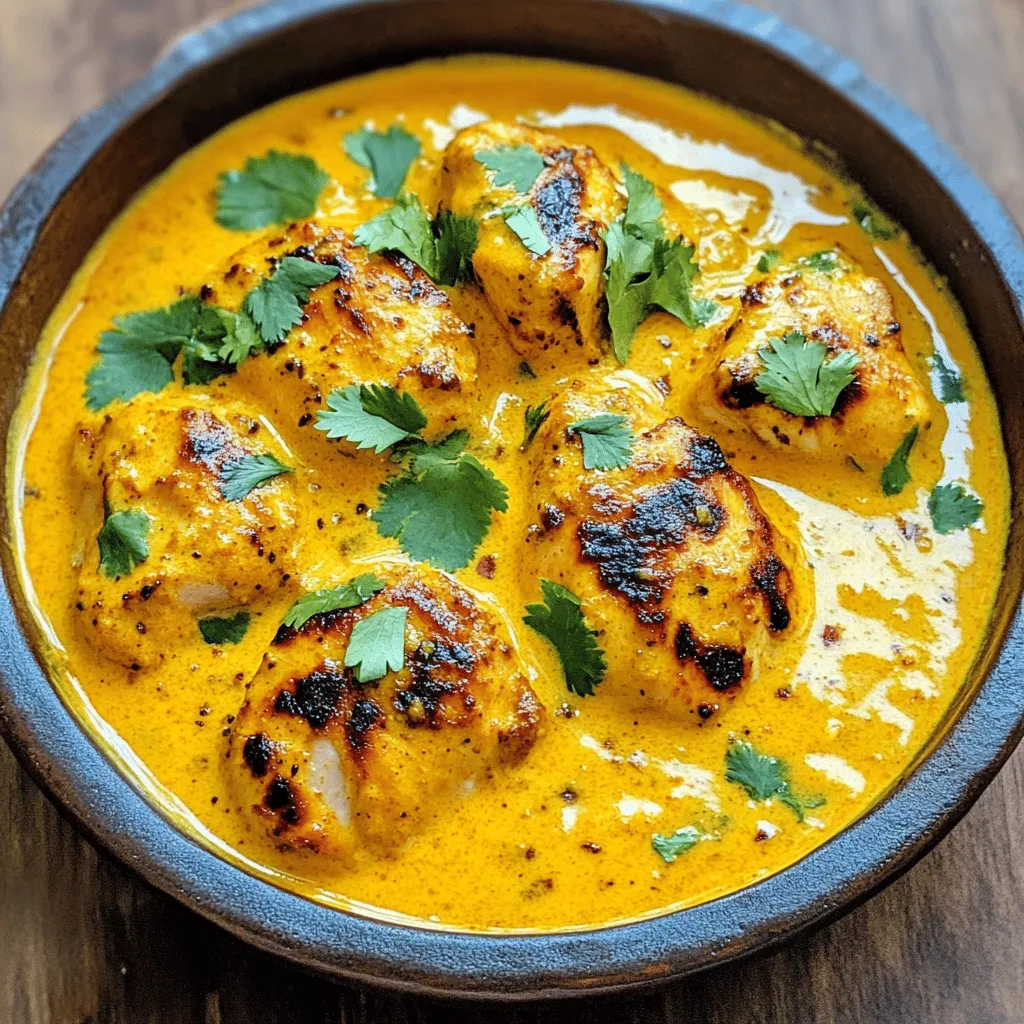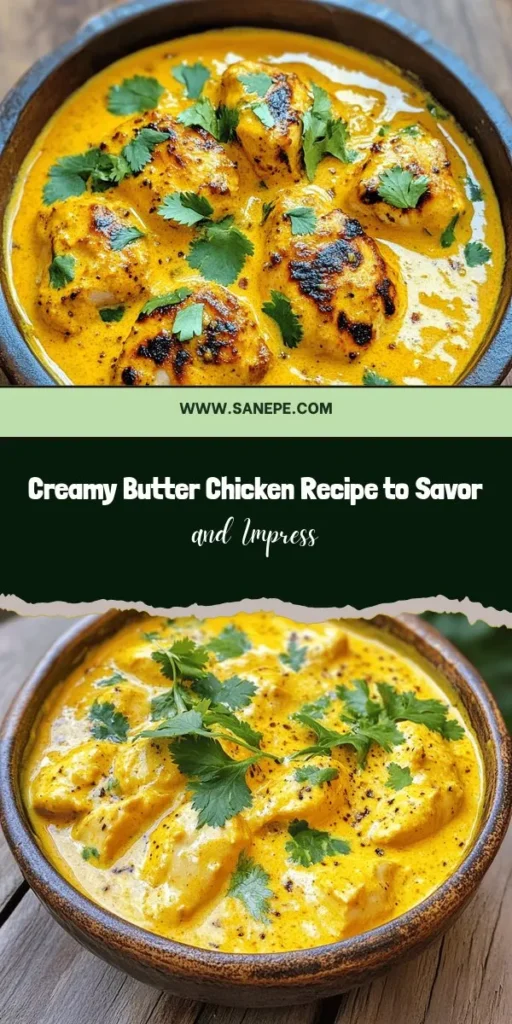Introduction
Butter Chicken, known as “Murgh Makhani” in its native India, is a dish that has captured the hearts and palates of food lovers around the world. This beloved Indian cuisine staple showcases the delicate balance between tender chicken and a luxuriously creamy sauce, making it a favorite in both restaurants and home kitchens. The dish perfectly marries the rich flavors of spices, butter, and cream to create an unforgettable experience for anyone who takes a bite.
The allure of Butter Chicken lies not only in its delightful flavor but also in its versatility. It can be served with a variety of accompaniments such as naan, rice, or roti, allowing you to customize your dining experience. This dish is not just a meal; it’s an experience that brings warmth and comfort to the table. Whether you are preparing it for a family gathering or a cozy dinner for two, Creamy Butter Chicken Delight is sure to impress your guests with its rich and savory profile.
In this article, we will guide you through a detailed recipe for Creamy Butter Chicken Delight. We’ll explore its historical roots, break down the essential ingredients, and provide step-by-step instructions to help you recreate this mouthwatering dish at home.
Understanding Butter Chicken
Historical Background of Butter Chicken
The origins of Butter Chicken can be traced back to the 1950s in Delhi, India, where it was created by the chefs at the Moti Mahal restaurant. The story goes that leftover chicken from the tandoor was transformed into a rich curry using a blend of tomatoes, butter, and cream. This innovative approach not only reduced food waste but also resulted in a dish that quickly gained popularity. Today, Butter Chicken is celebrated not only in India but also across the globe, with countless variations reflecting local tastes and ingredients.
Key Ingredients that Define Butter Chicken
The foundation of any great Butter Chicken lies in its key ingredients. While there are many regional variations, the core components typically include:
– Chicken: Traditionally, bone-in pieces are used, but boneless chicken thighs or breasts can also work wonderfully.
– Yogurt: This is used in the marinade to tenderize the chicken and add a tangy flavor.
– Spices: A blend of spices such as garam masala, cumin, coriander, turmeric, and chili powder create the signature flavor profile.
– Tomatoes: Fresh or canned tomatoes form the base of the sauce, providing sweetness and acidity.
– Butter and Cream: These ingredients are essential for achieving the creamy texture that Butter Chicken is known for.
Variations of the Dish Across Different Cultures
While Butter Chicken is quintessentially Indian, it has inspired a plethora of variations across different cultures. In countries like Canada and the United Kingdom, you may find Butter Chicken served in unique ways, such as in wraps or as part of a fusion dish. Some versions incorporate additional vegetables or alternate proteins, giving this classic dish a modern twist. No matter the variation, the essence of Butter Chicken remains the same: a celebration of rich flavors and comforting textures.
Ingredients Breakdown
Chicken Marinade Ingredients
To achieve the perfect Butter Chicken, the marination process is crucial. Here’s a closer look at the ingredients that make up the marinade:
– Chicken: 1.5 pounds of boneless, skinless chicken thighs or breasts, cut into bite-sized pieces.
– Yogurt: 1 cup of plain yogurt acts as a tenderizer and adds a tangy note to the chicken.
– Spices:
– 1 tablespoon garam masala
– 1 teaspoon cumin
– 1 teaspoon coriander
– 1 teaspoon turmeric
– 1 teaspoon chili powder
These spices not only enhance the flavor of the chicken but also infuse it with a vibrant color.
Role of Yogurt in Marination
Yogurt is a key player in marinating the chicken for Butter Chicken. Its acidity helps to break down the proteins in the meat, resulting in tender, juicy pieces. Additionally, yogurt adds a subtle tanginess that complements the rich flavors of the sauce.
Importance of Spices
The spices in Butter Chicken are what truly elevate the dish. Each spice contributes to the overall flavor profile, with garam masala offering warmth, cumin providing earthiness, coriander adding a hint of sweetness, turmeric introducing a beautiful golden hue, and chili powder giving it a gentle kick. The balance of these spices is what makes Butter Chicken truly special, allowing the flavors to meld beautifully during the cooking process.
Overview of the Butter Sauce Components
The sauce is the heart of Butter Chicken, and its components include:
– Butter: 4 tablespoons of unsalted butter are used to create a rich, creamy base.
– Cream: 1 cup of heavy cream contributes to the luxurious texture and flavor of the sauce.
– Tomatoes: 2 cups of pureed tomatoes (canned or fresh) add sweetness and acidity, balancing the richness of the butter and cream.
– Sugar: 1 teaspoon of sugar helps to enhance the natural sweetness of the tomatoes and rounds out the flavors.
Function of Butter and Cream
The combination of butter and cream is essential for creating the signature sauce of Butter Chicken. Butter adds a rich, savory flavor, while cream imparts a velvety texture that coats the chicken perfectly. This duo is what makes the sauce irresistibly creamy and indulgent.
Role of Tomatoes and Sugar in Balancing Flavors
Tomatoes serve as a base for the sauce, providing acidity that cuts through the richness of the butter and cream. The addition of sugar helps to balance the acidity of the tomatoes, resulting in a harmonious blend of flavors. This careful balance is what allows the dish to shine, ensuring that each bite is a delightful experience.
Significance of Garnishing with Cilantro
Cilantro is the final touch that elevates Butter Chicken to new heights. Not only does it add a pop of color, but it also contributes a fresh, herbaceous note that contrasts beautifully with the rich sauce. A sprinkle of chopped cilantro just before serving brings the dish together, making it visually appealing and flavorful.
Marinating the Chicken
Importance of Marination for Flavor Enhancement
Marinating the chicken is a crucial step in preparing Butter Chicken. This process allows the flavors from the yogurt and spices to penetrate the meat, resulting in a more flavorful and tender dish. A well-marinated chicken will absorb the spices, ensuring that every bite is packed with flavor.
Step-by-Step Guide to Preparing the Chicken Marinade
1. Prepare the Marinade: In a large mixing bowl, combine the yogurt, garam masala, cumin, coriander, turmeric, and chili powder. Mix well to create a smooth marinade.
2. Add the Chicken: Add the chicken pieces to the marinade, ensuring that each piece is thoroughly coated. This helps to maximize flavor absorption.
3. Cover and Refrigerate: Cover the bowl with plastic wrap or a lid and refrigerate for at least 1 hour. For optimal flavor, marinate for 4 to 6 hours or overnight if possible.
Recommended Marination Times for Optimal Flavor Absorption
While a minimum marination time of 1 hour will yield decent results, allowing the chicken to marinate for a longer period (4 to 6 hours or overnight) will enhance the flavor profile significantly. The longer the chicken sits in the marinade, the more it will absorb the spices, resulting in a more flavorful and tender final dish.
Cooking the Chicken
Techniques for Grilling or Pan-Searing Chicken
Once the chicken has marinated, it’s time to cook it. There are two popular methods for cooking the chicken for Butter Chicken: grilling and pan-searing.
– Grilling: If you prefer a smoky flavor, grilling the chicken is an excellent option. Preheat your grill to medium-high heat and cook the marinated chicken for about 5-7 minutes on each side, or until fully cooked and charred. This method imparts a deliciously grilled flavor to the chicken.
– Pan-Searing: For a quicker and equally delicious option, pan-searing is the way to go. Heat a tablespoon of oil in a large skillet over medium-high heat. Add the marinated chicken pieces in batches, being careful not to overcrowd the pan. Cook for about 5-6 minutes on each side, or until the chicken is golden brown and cooked through. This method allows the chicken to develop a lovely crust while remaining juicy on the inside.
With these preliminary steps covered, you’re well on your way to creating a delightful Creamy Butter Chicken that will impress your family and friends. Stay tuned as we delve deeper into the cooking process and the final assembly of this mouthwatering dish.

Tips for Achieving the Perfect Char on the Chicken
To achieve that unmistakable char on your chicken, begin by ensuring your grill or pan is preheated properly. The high temperature is essential for searing, which locks in moisture and flavor while creating a delicious crust.
1. Marination: Marinate the chicken for at least 30 minutes, or ideally overnight, to allow the spices to penetrate the meat. A marinade with yogurt not only adds flavor but also helps tenderize the chicken.
2. Avoid Overcrowding: When cooking, do not overcrowd the pan or grill. This prevents the chicken from searing properly and instead leads to steaming, which can make the chicken rubbery.
3. Basting: During the cooking process, consider basting the chicken with oil or melted butter. This adds flavor and helps achieve that golden-brown char.
4. Resting: After cooking, allow the chicken to rest for 5-10 minutes. This step is crucial as it lets the juices redistribute, ensuring moist and flavorful meat.
Safety Considerations When Cooking Chicken
Safety is paramount when handling raw chicken. Here are essential tips to prevent foodborne illnesses:
1. Thorough Cooking: Always ensure chicken is cooked to an internal temperature of 165°F (75°C). Use a meat thermometer for accuracy.
2. Cross-Contamination: Use separate cutting boards for raw chicken and other ingredients. Wash your hands, utensils, and surfaces thoroughly after handling raw poultry.
3. Storage: Keep raw chicken refrigerated at or below 40°F (4°C) and cook or freeze leftovers within two hours to prevent bacterial growth.
Preparing the Butter Sauce
Creating the butter sauce for your Creamy Butter Chicken is where the magic happens. Here’s a step-by-step guide:
1. Sautéing Onions:
– Heat a generous amount of ghee or unsalted butter in a large skillet over medium heat.
– Add finely chopped onions and cook until they turn translucent and slightly caramelized, approximately 8-10 minutes. This process develops the sauce’s sweetness and forms the base of the flavor profile.
2. Incorporating Aromatics:
– Add minced garlic, grated ginger, and chopped green chilies to the onions. Sauté for an additional 1-2 minutes until fragrant. This step is crucial as it layers the flavors, creating a robust foundation for your sauce.
3. Cooking the Tomatoes:
– Stir in crushed tomatoes (fresh or canned), ensuring they are well combined with the onion mixture.
– Allow the tomatoes to cook down for about 10-15 minutes, stirring occasionally. The goal is to reduce the sauce to a thick consistency. The natural sugars in the tomatoes will caramelize, enhancing the sauce’s overall flavor.
4. Incorporating Cream and Spices:
– Once the tomato mixture has thickened, lower the heat and add heavy cream. Stir until fully combined and let it simmer gently for a few minutes.
– Season with garam masala, turmeric, cumin, and salt, adjusting to taste. Add a pinch of sugar if you want to balance the acidity of the tomatoes.
Combining Chicken and Sauce
Once your chicken is perfectly cooked and your sauce is ready, it’s time to bring them together.
1. Blending Chicken with Sauce:
– Cut the grilled or pan-seared chicken into bite-sized pieces.
– Add the chicken pieces to the sauce and stir gently to coat them evenly. Make sure to do this on low heat to keep the chicken warm without overcooking it.
2. Adjusting Seasoning and Spice Levels:
– Taste your dish and adjust the seasoning as needed. If you prefer more heat, add a dash of cayenne pepper or extra green chilies. For a richer flavor, a bit more garam masala can enhance the taste.
3. Simmering to Meld Flavors:
– Let the combined chicken and sauce simmer together for about 10 minutes. This allows the chicken to absorb the sauce’s flavors, making each bite a delightful experience.
Serving Suggestions
Butter Chicken is best enjoyed with sides that complement its rich, creamy texture. Here are some traditional and creative serving ideas:
1. Traditional Accompaniments:
– Serve with warm naan or roti, which is perfect for scooping up the sauce.
– Basmati rice is another classic pairing, as its fragrant nature balances the rich flavors of the dish.
– For a heartier option, consider serving with parathas, which add a delightful texture.
2. Creative Serving Ideas:
– Pair your Butter Chicken with a refreshing salad for a lighter meal. A simple cucumber and tomato salad with a squeeze of lemon can add a nice contrast.
– Roasted vegetables, such as cauliflower or carrots, can enhance the meal with additional flavors and textures.
3. Presentation Tips:
– Garnish your Butter Chicken with fresh cilantro and a drizzle of cream for an elegant touch.
– Serve in a vibrant dish that contrasts with the golden hues of the sauce, making the meal visually appealing.
Nutritional Insights
Understanding the nutritional aspects of your Creamy Butter Chicken can help you enjoy it mindfully.
1. Nutritional Benefits:
– Chicken is an excellent source of lean protein, which is essential for muscle repair and overall health.
– The inclusion of spices not only enhances flavor but also provides health benefits, such as anti-inflammatory properties from turmeric and digestive benefits from ginger.
2. Calorie Content and Portion Control:
– A typical serving of Butter Chicken can range from 400-600 calories, depending on the cream and oil used. To keep portions in check, serving with a side of vegetables or salad can help balance the meal.
3. Healthier Substitutions:
– For a lighter version, consider using coconut milk or a blend of yogurt in place of heavy cream. These alternatives can provide a similar creaminess while reducing calorie counts.
– You can also opt for skinless chicken breast instead of thighs to decrease fat content without sacrificing flavor.
Conclusion
Creamy Butter Chicken is not just a meal; it’s an experience that brings warmth and comfort to any table. This recipe is straightforward, making it accessible for both novice cooks and seasoned chefs. The blend of spices, the creaminess of the sauce, and the tender chicken create a dish that is sure to impress.
By preparing this delightful recipe at home, you can savor the rich flavors and share a piece of culinary tradition with your family and friends. The joy of cooking and sharing a homemade meal is unparalleled, and this Creamy Butter Chicken offers a perfect opportunity to create lasting memories around the dining table. So, roll up your sleeves and embark on this flavorful adventure – your taste buds will thank you!


